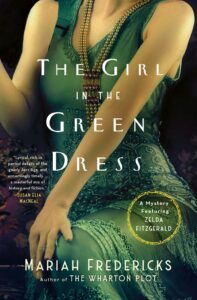 I love the way Mariah Fredericks writes. Her prose sings. And if you are going to write about one of the greatest of all prose stylists, F. Scott Fitzgerald, you’ve got to have game yourself. While Scott and the lovely Zelda are not the main characters in this novel, they certainly inform it in every possible way. The main character is a much lesser-known writer of the time, Morris Markey. Markey, a friend of James Thurber’s and James M. Cain’s, wrote for The New Yorker and wrote extensively (for the purposes of this novel) about the still unsolved murder of James Elwell in 1920, a “swell” found shot through the head in his library. His house happens to be across the street from Markey’s and he is one of the last people to have seen him alive, very early the morning of his death.
I love the way Mariah Fredericks writes. Her prose sings. And if you are going to write about one of the greatest of all prose stylists, F. Scott Fitzgerald, you’ve got to have game yourself. While Scott and the lovely Zelda are not the main characters in this novel, they certainly inform it in every possible way. The main character is a much lesser-known writer of the time, Morris Markey. Markey, a friend of James Thurber’s and James M. Cain’s, wrote for The New Yorker and wrote extensively (for the purposes of this novel) about the still unsolved murder of James Elwell in 1920, a “swell” found shot through the head in his library. His house happens to be across the street from Markey’s and he is one of the last people to have seen him alive, very early the morning of his death.
When Markey sees the obviously alarmed housekeeper outside his door he decides to “help” and goes inside to get a good look around, while obviously also taking a look at the injured man – meanwhile, he instructs the housekeeper to call an ambulance. The things he finds intrigue him and he begins to write stories about the death, as well as about the mysterious woman in a green dress who was seen with Elwell in front of his home in the early morning hours.
As Markey becomes increasingly obsessed with the girl, he realizes his tangential knowledge of the fabulous Fitzgeralds might be an entree into the world containing the woman in the green dress, and he makes the acquaintance of Scott and Zelda. It almost breaks your heart to have a virtual visit with these two fabulous creatures before unhappiness and early death captured them both. In 1920, they were young, beautiful and famous, Fitzgerald’s This Side of Paradise having recently been published. It’s almost hard to imagine a time when a writer would garner the attention a movie or music star would garner today, but Fredericks deftly recreates this atmosphere.
The strength of the novel is the beautiful way Fredericks recreates the time period, using Zelda as her muse. The troubled, beautiful, impulsive Zelda is Markey’s guide through high society, and as a reader you get to experience the 1920’s through Zelda’s golden gaze. It seems fragile but lovely, almost like the bubble surrounding the sanity of both Zelda and Markey. Markey suffers from PTSD (he served in the Red Cross during the war) and Zelda of course was famously troubled. Today we might diagnose her as bipolar, but that’s hardly the romantic feel Fredericks is aiming for.
As Zelda and Markey form a little team, peeling away the layers of Elwell’s death, they get closer and closer to the truth. Fredericks has rearranged facts to fit her fictional model, but the essentials are the same, and she frames the story with Markey’s apparent suicide, decades after this story had been told. The way Zelda and Markey interact – their similarly interior lives playing out very differently in action – is the main theme of the book. The way Fredericks as a writer is able to delineate character is her genius. She stays a bit hands off of Scott himself (good decision) but she does portray Zelda at the height of her beauty and fame in an utterly believable way.
Who has not been fascinated by Zelda? She’s a defining figure of the early 20th century and Fredericks takes her on beautifully. I also appreciated the solution to the murder which was unexpected and actually relied on Markey’s skills as a journalist. The novel is haunting, romantic, and ultimately tragic. — Robin Agnew